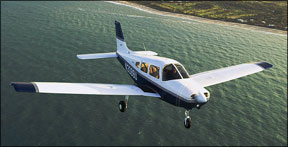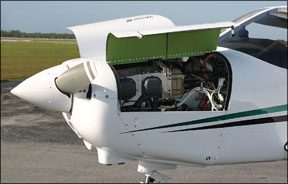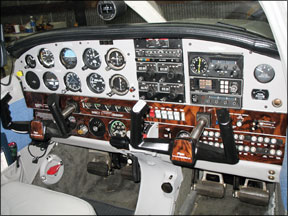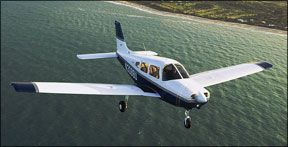When considering basic airplanes, the 150/160-hp four-place, fixed-gear single is about as ubiquitous as one can get. The niche serves as the beginning rung of a market ladder where airplanes begin to be used as practical transportation tools. They wont haul a lot of people or cargo, nor will they do it quickly, but they offer economical travel. They often serve as a pilots first “real” airplane after primary training, and the market demands they be reliable, inexpensive to operate and relatively easy to fly. Airplanes in this class are sort of like Toyotas: not terribly exciting or fancy, perhaps, but they do what you need them to without costing an arm and a leg. Cessnas Skyhawk owns this market, of course, and used-airplane prices reflect that dominance. At least two of its mainstream competitors, the Piper PA-28-151 or -161 Warrior and AGAC AA-5 Traveler/Cheetah, are good, solid airplanes that can be had for less. (Beechs entry, the Sport, is short on performance when compared to the Warrior and Cheetah.) The AA-5 went the way of the dodo in the late 1970s, and attempts to resurrect it (in the form of the Tiger) failed. Beginning in the mid-1980s, Piper, too, fell on hard times and was forced into bankruptcy, finally emerging several years (and a few abortive buyout attempts) later as the New Piper. In 2006, “new” was dropped from the companys name. Unlike the Skyhawk, and with only one or two exceptions, the Warrior has been in production throughout, even if the number of airframes manufactured in each model year could be counted on the fingers of one hand. Now in the “Warrior III” configuration, the model is marketed mainly as a trainer. A glance at current prices of mid-1980s Skyhawks and Warriors shows the PA-28-151/161 is a bargain compared to the Skyhawk: The 1984 Cessna averages $26,000 more than an 84 Warrior, according to the 
History
As general aviation was entering its heyday of the 1970s, Pipers line was beginning to look a little dated. The basic PA-28 had come out in 1962, and hadnt changed all that much in the intervening years. Pipers PA-28 and -32 singles all had the characteristic, constant-chord “Hershey bar” wing, and the company was about to lower the boom on the sleek Comanche. It was time to update the line.
A new airplane was planned, one that would take aim squarely at the Cessna Skyhawk. Previously, Piper didnt really have a direct competitor for the Cessna 172, even though it offered Cherokees with 150 or 160 horses through most of the 1960s. The Cherokee 140 was more cramped, being more of a 2+2 airplane than a true four-place, and it didnt perform as we’ll as the Skyhawk.
The first Warrior was introduced in 1974, powered by a 150-hp Lycoming O-320-E3D engine. It didnt replace the Cherokee 140, though the 140 did succumb to poor sales after the 1977 model year.
The Warrior boasted one big difference: A new, longer semi-tapered wing with a higher aspect ratio. This new wing helped the handling, with lighter roll control forces, and also boosted the climb rate. It also helped the airplanes looks. The new wing design first appeared on the Warrior, but eventually found its way into all of the PA-28 series as we’ll as onto the PA-32.
Interestingly, the new design represented a deviation from the production efficiencies originally touted as a virtue of the constant-chord wing. And its fun to recall some Piper engineers back when it was introduced
boasting that the fat, new, stubby wing was actually every bit as good as the sexier-looking tapered Comanche wing, aerodynamically. Pipers most significant upgrade to the Warrior came in 1977 when a slightly different O-320 engine-the -D3G-was bolted on, offering a 10-hp boost in output. The results were dubbed “Warrior II.”
A couple of other evolutionary changes occurred in 1978, when Warriors received more streamlined wheel fairings, and in 1983, when the battery was removed from under the rear seat and placed in front of the firewall. The new fairings-aftermarket versions of which are available under STC-yielded some seven knots in cruise speed according to the book, while the battery change shortened the run to the starter and helped combat starting problems (though these had been largely overcome, according to users, by swapping copper for aluminum cables).
Thanks to the change in weight and balance, shifting the battery location allowed the gross weight and useful load to be hiked by 115 pounds, and extended the aft CG to allow more of a load in the baggage compartment. (The boost is available via STC for older 160-hp Warriors.)
An attempt to create some interest in a moribund new-airplane market was made in 1988, when Piper released a version of the Warrior targeting flight schools called the Cadet. Basically a stripped-down version lacking creature comforts, it was available in VFR and IFR versions. The experiment continued through the 1994 model year. Another spruce-up resulted in the Warrior III in 1995, the model currently in production.

Today, a new Warrior III with standard equipment will set you back $201,400. An average 1974 Warrior model brings about $29,000.
Performance
The 10-HP boost in power raised the 75-percent cruise speed from 116 knots to 121 knots. And the new speed fairings nudged that up to 127 knots-not exactly blinding, but squarely in league with the Skyhawk, even if easily eclipsed by the Cheetah. Owners report real-world performance is somewhat less than the book figures: One owner of a 160-hp model cruises his at 115 KTAS, while another says his tops out at 120 KTAS. On the good side, the fuel burn at 100 KTAS can be as low as 8 GPH.
One big gripe by owners of the 150-hp model is a miserable climb rate. “Its taken me to 292 airports in 35 states. As a Jack of All Trades (master of none), it does not climb rapidly, carry a lot of weight, or go fast,” wrote one owner of a 150-HP model.
One of the nice features is a generous 50-gallon fuel load (with 48 gallons usable). Burning 7.5 to 10 GPH at cruise, these birds yield a fairly good range with four to six hours of flying. One pilot said he flight-planned for 4.45 hours with a 45-minute reserve. Still, another owner faulted the fuel capacity, saying “There are times when 50 gallons has been limiting and I would have liked to have had at least 72 gallons, as did some of the Arrows.”
Runway performance is adequate, with an owner of a 160-hp model reporting his being flown from a grass runway. He says the airplane is “adequate for the 2600-foot strip. Im careful with four passengers on high density altitude days,” however, especially if the grass hasnt been mowed.
Comfort/Loading
While past respondents rated comfort only as average, the current consensus is its quite good. Later Pipers benefit from having some of the best seats in general aviation, from both a comfort and crashworthiness standpoint. These seats are designed with an S-tube frame similar to the legendary JAARS seat, which progressively deforms during impact, absorbing energy before it reaches the occupant. For greater pilot comfort, there is an optional vertical seat adjustment which some say is great but others say is prone to malfunctioning.
The fuel selector is located out of sight alongside the pilots left knee. The need to switch tanks left and right results in more fuel mismanagement errors than with the “both tanks” system on the high-wing Cessnas, judging from the accident reports. Naturally, its also easy to develop an imbalance unless the pilot remembers to switch regularly and there is no aileron trim for the airplane. This makes at least a wing-leveler autopilot a nice option, in our opinion.
The Warriors parking brake is a robust handle sticking out from the bottom of the panel. Its simple and strong, and it works. The same goes for the flap system. Its manual, positive, blessedly simple and it just doesnt break.
Like most low-wing aircraft, however, entry and exit is awkward. The Warrior has only one door, so three of the four occupants have to do some contortions to get in place. Emergency egress is problematical, since the rear windows cannot be opened in an emergency (like those of some Bonanzas, for example). The baggage door is fairly large, however.
Naturally, with a full load of 50 gallons, the Warrior wont carry four adults, but some owners report fuelling up only to the tabs (34 gallons), accepting the reduced range and legally flying off to their destination. The baggage compartment will take a full 200 pounds structurally, the same as more powerful PA-28s. Thats a lot more than the Skyhawk and Cheetahs maximum of 120 pounds, by comparison.
Owners say nice things about cabin ventilation, thanks to an abundance of outlets, both overhead and underneath. Unfortunately, there were complaints that in winter the overhead vents were too much of a good thing and could not be completely shut off, giving passengers the chills. Pilots have solved this problem by simply taping up the exterior air inlet on the tail in the winter.
A few owners had the air conditioning systems available as options on the Cherokee line. Those who did felt the cool air yield in summer was not worth the sacrifice in already-limited payload and performance.
Handling
The Warrior shares with the other Cherokees a gentle nature, pleasant handling and such a reluctance to stall aggressively that some pilots rate it a poor teacher. Several respondents said that with both rudder and stabilator trim, the airplane does not need an autopilot.
Wed rate runway handling as decent, despite the large number of accidents on both takeoff and landing-especially landing-we uncovered in past checks of FAA accident and incident reports. It appears most of these stem from student indiscretions.
Pilots report they like the way the aircraft handles in a crosswind landing and feel more secure taxiing in windy conditions with the wide gear stance, as opposed to operating in the high-wing Cessnas.
Competition

The Cessna Skyhawk and the AGAC Traveler/Cheetah are the most logical competitors to the Warrior for the attention of buyers who want four-seaters that wont break the bank and who are willing to settle for modest performance.
The Cessna has by far the best overall safety record. In a cross-country race, the Traveler/Cheetah likely would barely edge out a 160-hp Warrior with the later wheelpants, and leave the Cessna and the older Warriors in its propwash. And while the Traveler/Cheetah has the most pleasant, facile handling, in our book, its flaps are definitely inferior for getting into short fields. The Cessna gets our nod for getting in and out of little runways.
Maintenance
Heres where the Warrior should shine, since its the opposite of high-tech sophistication. Its got fixed gear, a fixed-pitch prop, mechanical flaps and a small-bore carbureted engine. It also comes with a cowling providing the best engine access in its class: Doors on either side of the cowling are hinged at the top and secured with double latches. By contrast, gaining similar access to a Skyhawks engine requires removing several screws and then lifting off the cowlings upper half, a two-person job when done correctly.
As expected, owners report relatively low maintenance costs and modest annual inspection fees. But its
a good thing they have that cowling: the engine compartment is the source of most upkeep problems. Our checks of Service Difficulty Reports (SDRs) showed a lot of Slick magneto failures. The powerplant itself was tagged with numerous failure modes, with valves at the top of the list, then following up with camshaft/lifter/pushrod problems, cylinder cracks and rocker arm breakage.
One particularly thorny issue involved a fuel starvation problem technicians could not duplicate. Eventually, after replacing the electric boost pump with a new one and monitoring flow rates with a vacuum gauge, a malfunctioning check valve was discovered to be the culprit. When not in use, fuel continues to flow through the boost pump; a failed check valve prevented flow, quieting the engine if not the pilot.
A lot of the magneto failures were attributed to failed bearings and some to malfunctioning impulse couplings and worn bushings, along with loose distributor gear fingers. Several other assorted magneto breakdown problems were listed in the SDRs, as well.
Potential buyers should check to see if there is roughness following engine start, since according to Lycoming thats one sign the exhaust valves are beginning to stick. (The roughness usually goes away after the engine warms up, incidentally.) That presumes the engine starts; several SDRs involved failed starters on newer Warriors.
High-time Warriors usually got that way as a result of being in a training environment. As one result, landing gear components and attach points, along with their fasteners, are subject to numerous cracks and corrosion.
If youre looking at a Warrior equipped with air conditioning, take a look at the bracket that attaches the alternator and compressor. We noted reports that the mounting bolts had broken or worked loose. And in one case the submitter found the bracket was installed backwards, subjecting the rear tab of the alternator to stress and misalignment of the pulleys.
Mods/User Groups
One series of mods available from Art Mattsons R&D (www.pipermods.com) for earlier PA-28 models also can be installed on Warriors. These include a set of vortex generators, modifications to the standard Sensenich prop blade designed to reduce drag, a new, more-efficient cowling and-for -151 Warriors-an upgrade to 160 HP. We have no direct information on these mods effectiveness, but Mattson has regularly set speed records in his Cherokee 140.
Owners of 1977 through 1982 Warrior IIs also can get a gross weight increase, from 2325 up to a whopping 2440 pounds. Mostly a paperwork exercise requiring only installing a placard and carrying a later Piper information manual, the STC gives early -161 owners the same gross weight 1983 and later models enjoy. Air East Airways, Inc. (631-756-5500), offers this mod.
Another interesting STC involves installing a supplemental storage area under the baggage compartment floor, capable of storing up to 25 lbs. The mod, available from Aircrafters, Inc. (951-304-1292), includes all parts and paperwork necessary for the conversion.
Other mods include the usual from LoPresti Speed Merchants (www.speedmods.com), Met-Co-Aire (www.metcoaire.com) and Knots-2-U (www.knots2u.com). The offerings include gap seals, new wingtips-including tips with landing/recognition lights.
As with any personal airplane, we strongly recommend joining its type club. Their expertise can save real money when tracking down common parts and problems. Warrior owners are fortunate in that they have two excellent organizations from which to choose: Cherokee Pilots Association (www.piperowner.com) and the Piper Owner Society (www.piperowner.org).
Owner Comments
My grandfather and I purchased a 1978 PA-28-161 Piper Warrior II in 2001. After being out of aviation for 15 years, he was looking for an easy-to-fly aircraft as fun to fly as the Cubs and Champs he used in the “golden days.” I was looking for an airplane that would make a good learning platform since I was still 15 years old at the time and wanted to get all of my ratings to make a career in aviation. We both preferred the looks of a low wing.
The Piper Warrior II met all of our requirements and exceeded many of our expectations. I now have my commercial multi-engine license with instrument and sea plane ratings and still enjoy flying this airplane. Im confident it will be in my family for generations and hopefully my children will learn to fly in it just as I did.
The Warrior is great for training but still makes a good cross-country airplane for trips within a few-state area. I can load full fuel, carry three average passengers on an average day and still get decent performance. The cargo area is spacious and can carry up to 200 pounds. The airplane also has better-than-expected soft- and short-field performance.
We have been very fortunate with this airplane and have had no engine trouble or any costly repairs since we have owned it. It had new leather interior and new paint; it also had 20 hours SMOH done by Penn Yan Aero. At our last annual we had put around 300 hours on the engine since we have owned it. The radios are original Collins but we have made a few other upgrades. We have added LoPresti wing tip landing lights, a wonderful addition, and we have a Garmin 496 with XM radio and weather mounted on the left yoke, with a Garmin 296 on the right one. We also replaced the original compass with a vertical card. Id like to add Rosen sun visors; we still have the originals, but they need replacement.
The only complaint is the door seal. We have tried several door seals but none of them seem to fit properly. Some of them leak, others even allow wind in. The factory seal was okay but was worn out when we purchased this aircraft.
I plan for 10 GPH to be safe; this usually gives me 125 knots at between 3000-to-6000 feet MLS. Our insurance is $1814 per year with Avemco, for $1 million total coverage with $100,000 per-person limits. With insurance, hangar, maintenance, oil and other expenses, the airplane costs $85/hour to fly. We flew it only 85 hours this year.
A less meticulous owner can certainly maintain a plane like this for less money. Our Warrior is maintained at higher-than-airline standards: We do not fly an airplane with any squawks. The exterior of this Warrior doesnt have a bug on it. I keep it spotless and am very particular with it. We have it professionally detailed yearly. We have the oil changed every 25 hours and an IA does periodic engine and brake checks in addition to the annual. In my opinion, this is what it takes to have a first-class and reliable machine that gets you where you need to go.
We enjoy this airplane a lot: It has reasonable speeds and good range, with a per-hour cost that doesnt break the checkbook. You cant beat the Warrior for a solid trainer or for an airplane for the $100 hamburger. This is a great first airplane thats fun to fly.
Matthew Miller
Via e-mail





